Estimation of Low Flow Statistics for Sustainable Water Resources Management in South Australia
Abstract
:1. Introduction
2. Materials and Methods
2.1. Study Area
2.2. Data Collection
2.3. Fitting Distribution Functions to the Observed Minima Series
- = Low flow quantile
- = Mean quantile
- = Random sample number
- = Root mean square error
2.4. Monte Carlo Simulations
3. Results
4. Discussion
5. Conclusions
Author Contributions
Funding
Institutional Review Board Statement
Informed Consent Statement
Data Availability Statement
Acknowledgments
Conflicts of Interest
Abbreviations
| Abbreviation | Description | Page no. |
| AHD | Australian Height Datum | 4 |
| ARI | Average Recurrence Interval | 1 |
| GEV | Generalized Extreme Value | 1 |
| GP | Generalized Pareto | 3 |
| LH moments | A generalization of L moments—based on high order statistics | 3 |
| LN | Log Normal | 1 |
| LP3 | Log Pearson Type 3 | 1 |
| MoM | Method of Moments | 1 |
| RMSE | Root Mean Square Error | 1 |
| SA | South Australia | 1 |
References
- Thornton, P.K.; Ericksen, P.J.; Herrero, M.; Challinor, A.J. Climate Variability and Vulnerability to Climate Change: A Review. Glob. Chang. Biol. 2014, 20, 3313–3328. [Google Scholar] [CrossRef] [PubMed]
- Kroll, C.N.; Vogel, R.M. Probability Distribution of Low Streamflow Series in the United States. J. Hydrol. Eng. 2002, 7, 137–146. [Google Scholar] [CrossRef] [Green Version]
- Yue, S.; Pilon, P. Probability Distribution Type of Canadian Annual Minimum Streamflow. Hydrol. Sci. J. 2005, 50, 427–438. [Google Scholar] [CrossRef]
- Yue, S.; Wang, C.Y. Possible Regional Probability Distribution Type of Canadian Annual Streamflow by L-Moments. Water Resour. Manag. 2004, 18, 425–438. [Google Scholar] [CrossRef]
- Acreman, M.; Dunbar, M. Defining Environmental River Flow Requirements—A Review. Hydrol. Earth Syst. Sci. 2004, 8, 861–876. [Google Scholar] [CrossRef]
- Kroll, C.; Luz, J.; Allen, B.; Vogel, R.M. Developing a Watershed Characteristics Database to Improve Low Streamflow Prediction. J. Hydrol. Eng. 2004, 9, 116–125. [Google Scholar] [CrossRef] [Green Version]
- Nathan, R.J.; McMahon, T.A. Overview of a Systems Approach to the Prediction of Low Flow Characteristics in Ungauged Catchments. In National Conference Publication; Institution of Engineers, Australia: Barton, Australia, 1991; Volume 1, pp. 187–192. [Google Scholar]
- Nathan, R.J.; McMahon, T.A. Estimating Low Flow Characteristics in Ungauged Catchments. Water Resour. Manag. 1992, 6, 85–100. [Google Scholar] [CrossRef]
- Hewa, G.H. A Methodology for Regional Low Flow Frequency Analysis. Doctoral Dissertation, University of Melbourne, Melbourne, Australia, 2001. [Google Scholar]
- Hewa, G.A. Comparing the Performance of Four Selected Models in Low Flow Frequency Analyses—A Case of Scott Creek in South Australia. In 31st Hydrology and water resources symposium and the 4th International Conference on Water Resources and Environment Research 2008; Engineers Australia: Barton, Australia, 2008. [Google Scholar]
- Zaidman, M.D.; Keller, V.; Young, A.R. Low Flow Frequency Analysis Guidelines for Best Practice; Environment Agency: Bristol, UK, 2002. Available online: https://assets.publishing.service.gov.uk/government/uploads/system/uploads/att (accessed on 6 August 2022).
- Zaidman, M.D.; Keller, V.; Young, A.R.; Cadman, D. Flow-Duration-Frequency Behaviour of British Rivers Based on Annual Minima Data. J. Hydrol. 2003, 277, 195–213. [Google Scholar] [CrossRef]
- Escalante-Sandoval, C.A. Mixed Distributions in Low-Flow Frequency Analysis. Ing. Investig. Tecnol. 2009, 10, 247–253. [Google Scholar] [CrossRef]
- Patel, J.A. Evaluation of Low Flow Estimation Techniques for Ungauged Catchments. Water Environ. J. 2007, 21, 41–46. [Google Scholar] [CrossRef]
- Vivekanandan, N.; Poornima, R. A Study on Comparison of Probability Distributions for Frequency Analysis of Low-Flow. Civ. Eng. Res. J. 2021, 11, 72–78. [Google Scholar] [CrossRef]
- Wallis, J.R.; Matalas, N.C.; Slack, J.R. Just a Moment! Water Resour. Res. 1974, 10, 211–219. [Google Scholar] [CrossRef] [Green Version]
- Vogel, R.M.; Fennessey, N.M. L-Moments Diagram Should Replace Product Moment Diagrams. Water Resour. Res. 1993, 29, 1745–1752. [Google Scholar] [CrossRef]
- Hewa, G.A.; Wang, Q.J.; McMahon, T.A.; Nathan, R.J.; Peel, M.C. Generalized Extreme Value Distribution Fitted by LH Moments for Low-Flow Frequency Analysis. Water Resour. Res. 2007, 43, W06301. [Google Scholar] [CrossRef] [Green Version]
- Durrans, S.R.; Tomic, S. Comparison of Parametric Tail Estimators for Lowflow Frequency Analysis. J. Am. Water Resour. Assoc. 2001, 37, 1203–1214. [Google Scholar] [CrossRef]
- Tasker, G.D. Regionalization of Low Flow Characteristics Using Logistic and GLS Regression. In New Directions for Surface Water Modeling (Proceedings of the Baltimore Symposium); Kavvas, M.L., Ed.; International Association of Hydrological Sciences Publication (IAHS) Publication: Baltimore, MD, USA, 1989; pp. 323–331. [Google Scholar]
- Vogel, R.M.; Kroll, C.N. Low-Flow Frequency Analysis Using Probability-Plot Correlation Coefficients. J. Water Resour. Plan. Manag. 1989, 115, 338–357. [Google Scholar] [CrossRef] [Green Version]
- Griffis, V.W.; Stedinger, J.R.; Cohn, T.A. Log Pearson Type 3 Quantile Estimators with Regional Skew Information and Low Outlier Adjustments. Water Resour. Res. 2004, 40, W07503. [Google Scholar] [CrossRef]
- Tallaksen, L.; Hewa, G. Extreme Value Analysis. In Manual on Low-Flow Estimation and Prediction; World Meteorological Organization: Geneva, Switzerland, 2008. [Google Scholar]
- International Organization for Standardization (ISO). ISO IEC Guide 98-3—Uncertainty of Measurement—Part 3: Guide to the Expression of Uncertainty in Measurement (GUM;1995); ISO: Geneva, Switzerland, 2008; Available online: https://www.iso.org/standard/50461.html (accessed on 6 August 2022).
- Bureau of Meteorology and the CSIRO. Regional Weather and Climate Guide. Available online: http://www.bom.gov.au/climate/climate-guides/guides/050-Northern-and-Yorke-SA-Climate-Guide.pdf. (accessed on 6 August 2022).
- Smakhtin, V.U. Low Flow Hydrology: A Review. J. Hydrol. 2001, 240, 147–186. [Google Scholar] [CrossRef]
- Lee, K.S.; Kim, S.U. Identification of Uncertainty in Low Flow Frequency Analysis Using Bayesian MCMC Method. Hydrol. Process. 2008, 22, 1949–1964. [Google Scholar] [CrossRef]
- Ouarda, T.B.M.J.; Charron, C.; St-Hilaire, A. Statistical Models and the Estimation of Low Flows. Can. Water Resour. J. 2008, 33, 195–206. [Google Scholar] [CrossRef] [Green Version]
- Jung, K.; Kim, E.; Kang, B. Estimation of Low-Flow in South Korean River Basins Using a Canonical Correlation Analysis and Neural Network (CCA-NN) Based Regional Frequency Analysis. Atmosphere 2019, 10, 695. [Google Scholar] [CrossRef] [Green Version]
- Khan, M.S.U.R.; Hussain, Z.; Ahmad, I.; Noor, F. Modeling of Flood Extremes Using Regional Frequency Analysis of Sites of Khyber Pakhtunkhwa, Pakistan. J. Flood Risk Manag. 2021, 14, e12751. [Google Scholar] [CrossRef]
- Wilhite, D.; Svoboda, M. Drought Early Warning Systems in the Context of Drought Preparedness and Mitigation, in Early Warning Systems for Drought Preparedness and Drought Management; National Drought Mitigation Center: Lincoln, NE, USA, 2000. [Google Scholar]
- Sheffield, J.; Wood, E. Projected Changes in Drought Occurrence under Future Global Warming from Multi-Model, Multi-Scenario, IPCC AR4 Simulations. Clim. Dyn. 2007, 31, 79–105. [Google Scholar] [CrossRef]
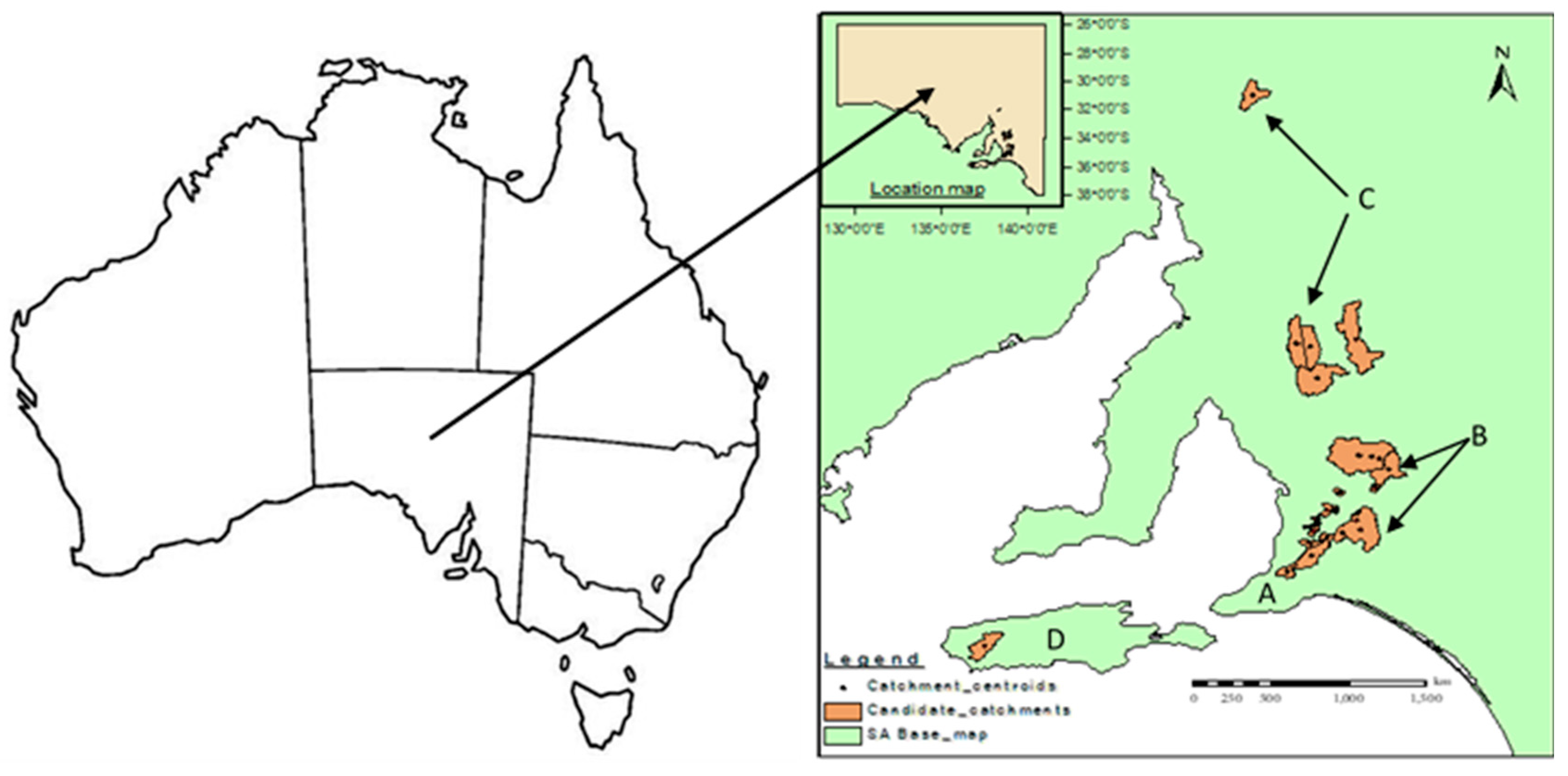
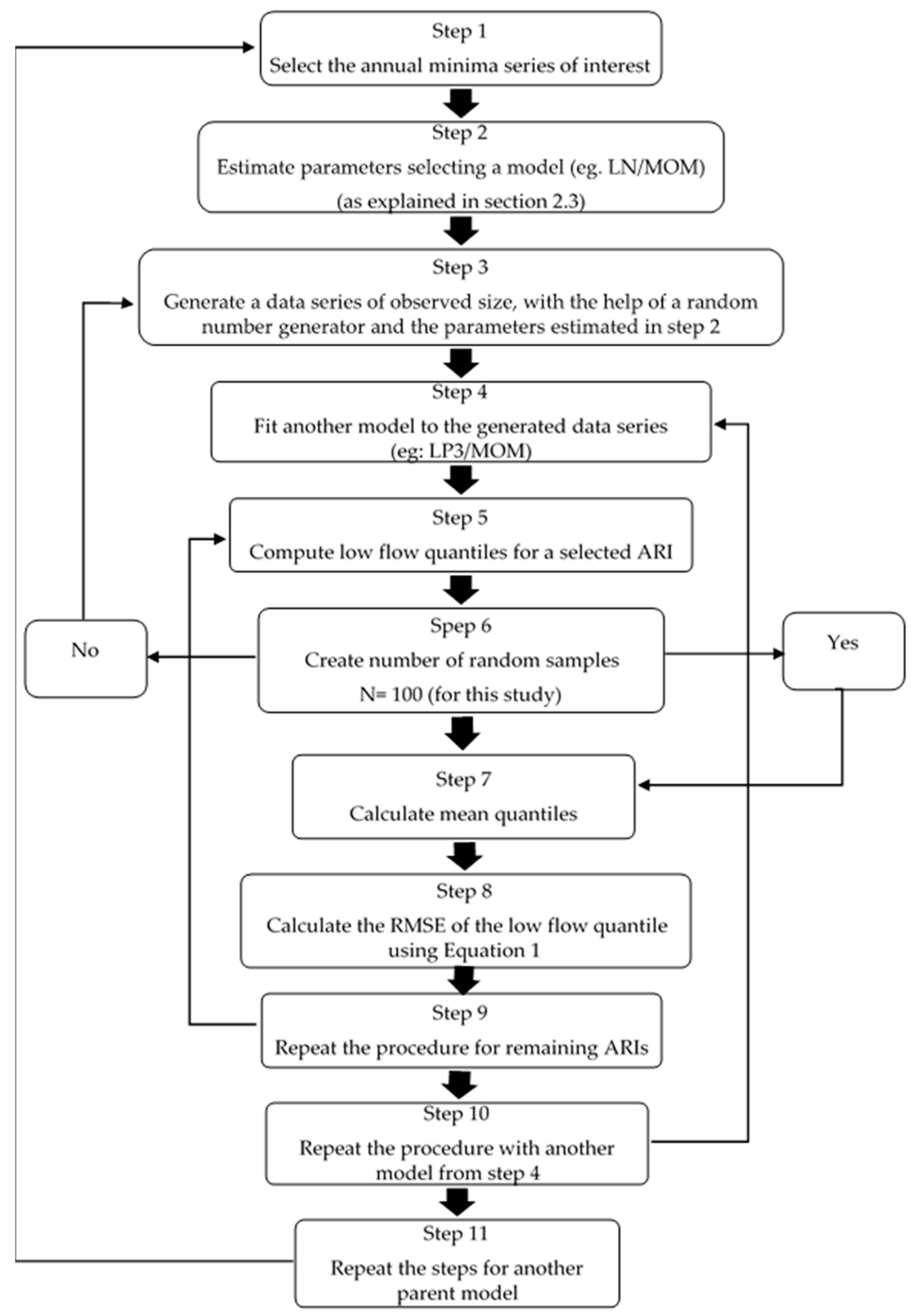
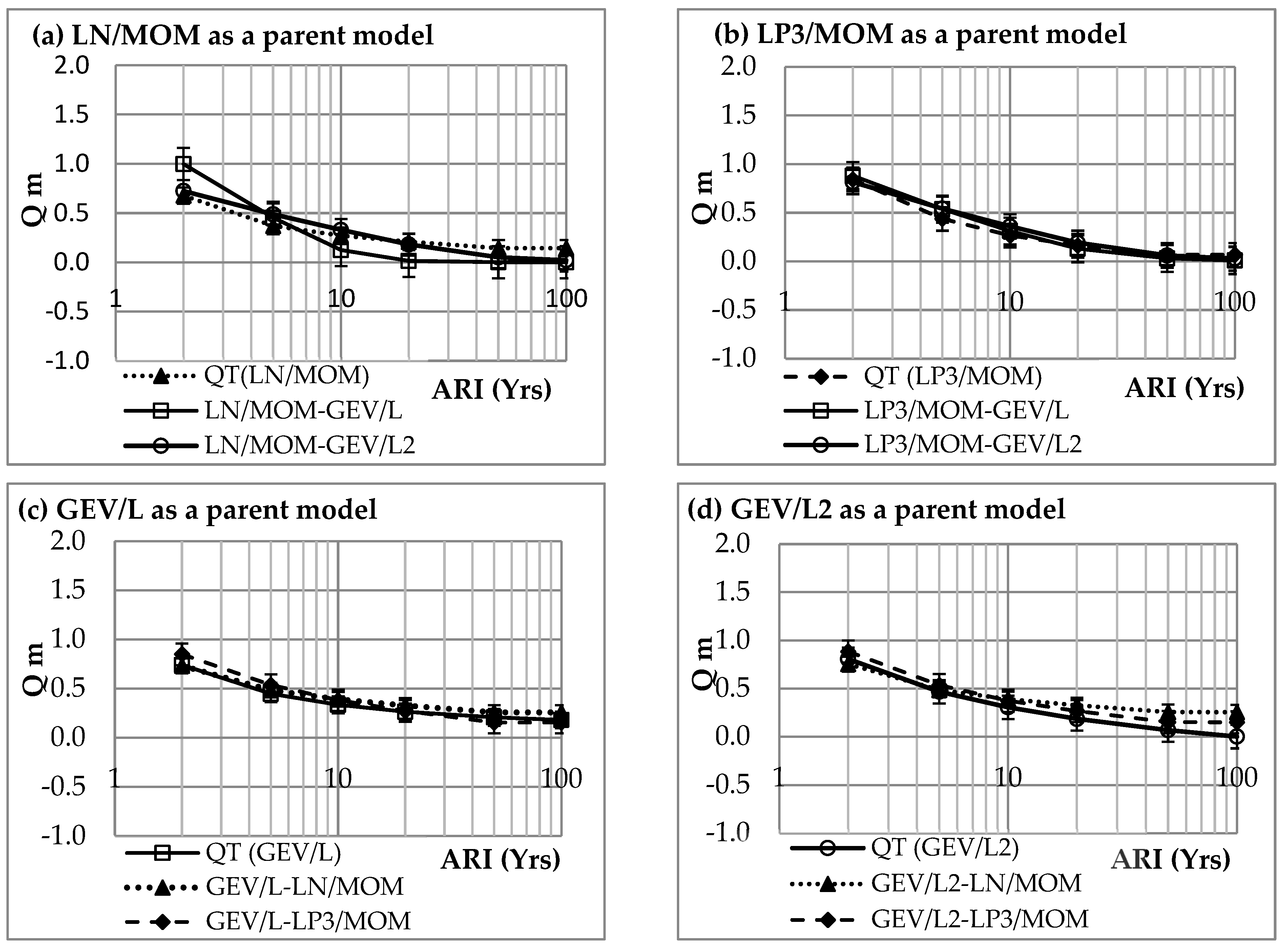
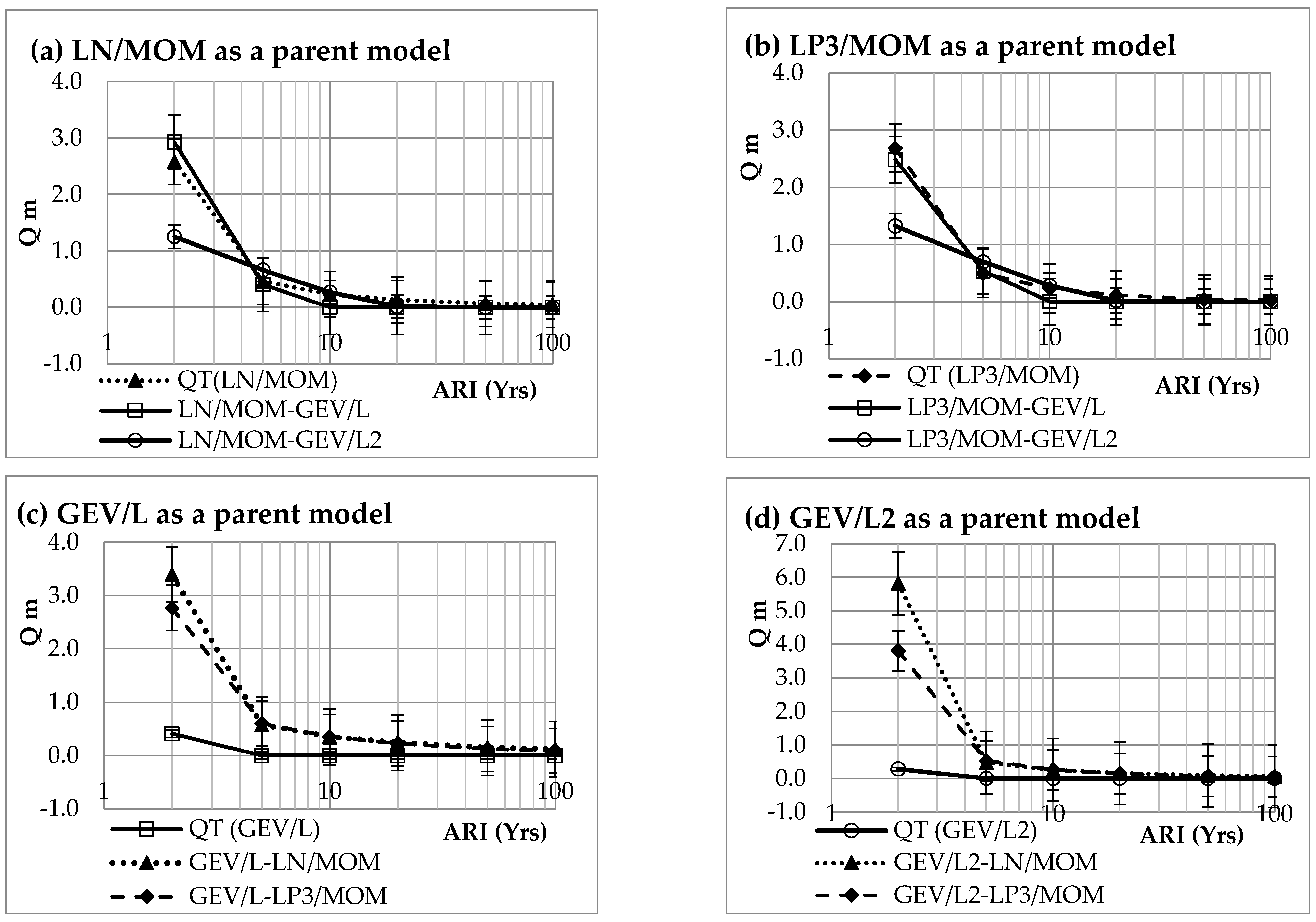
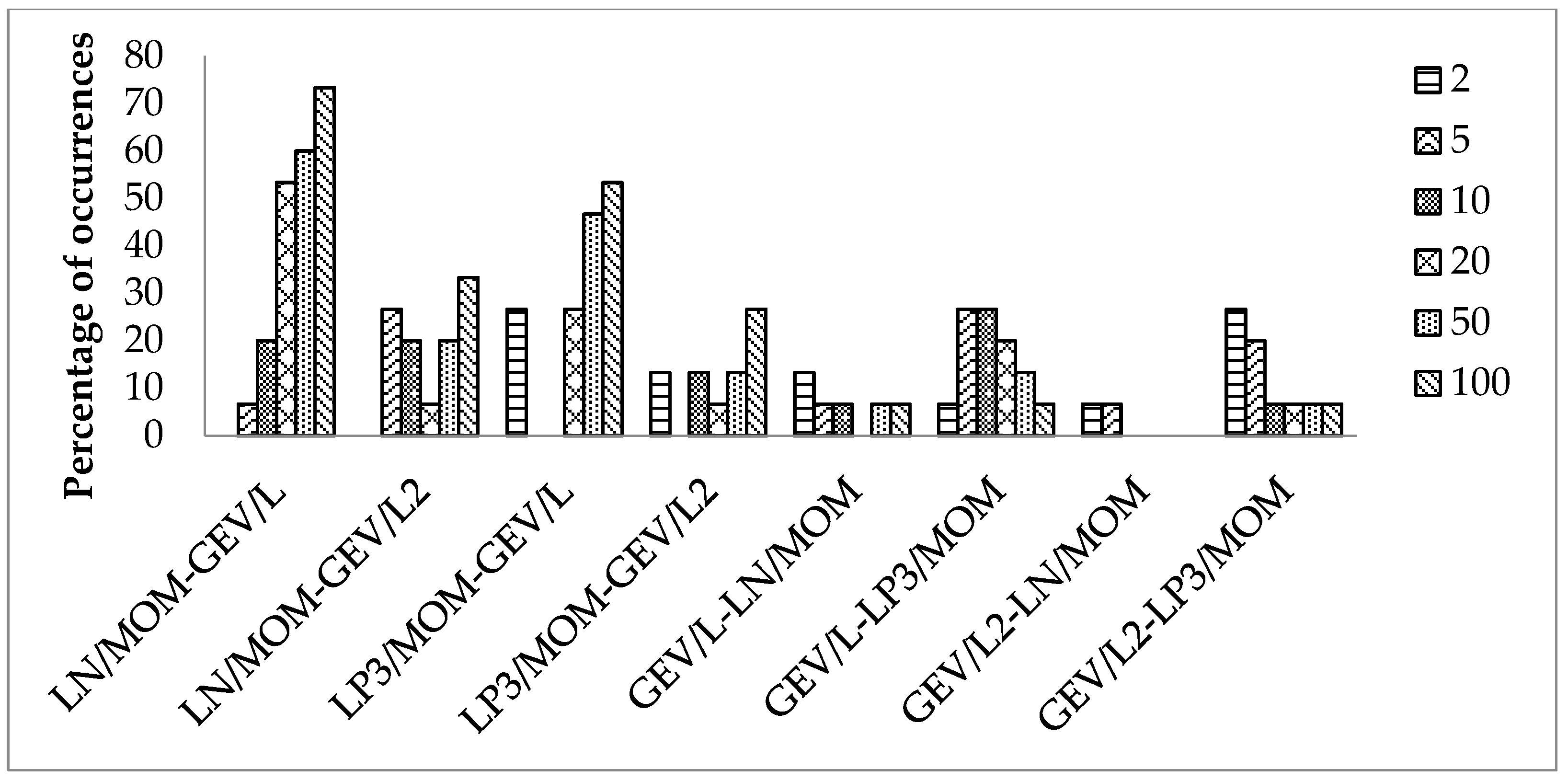
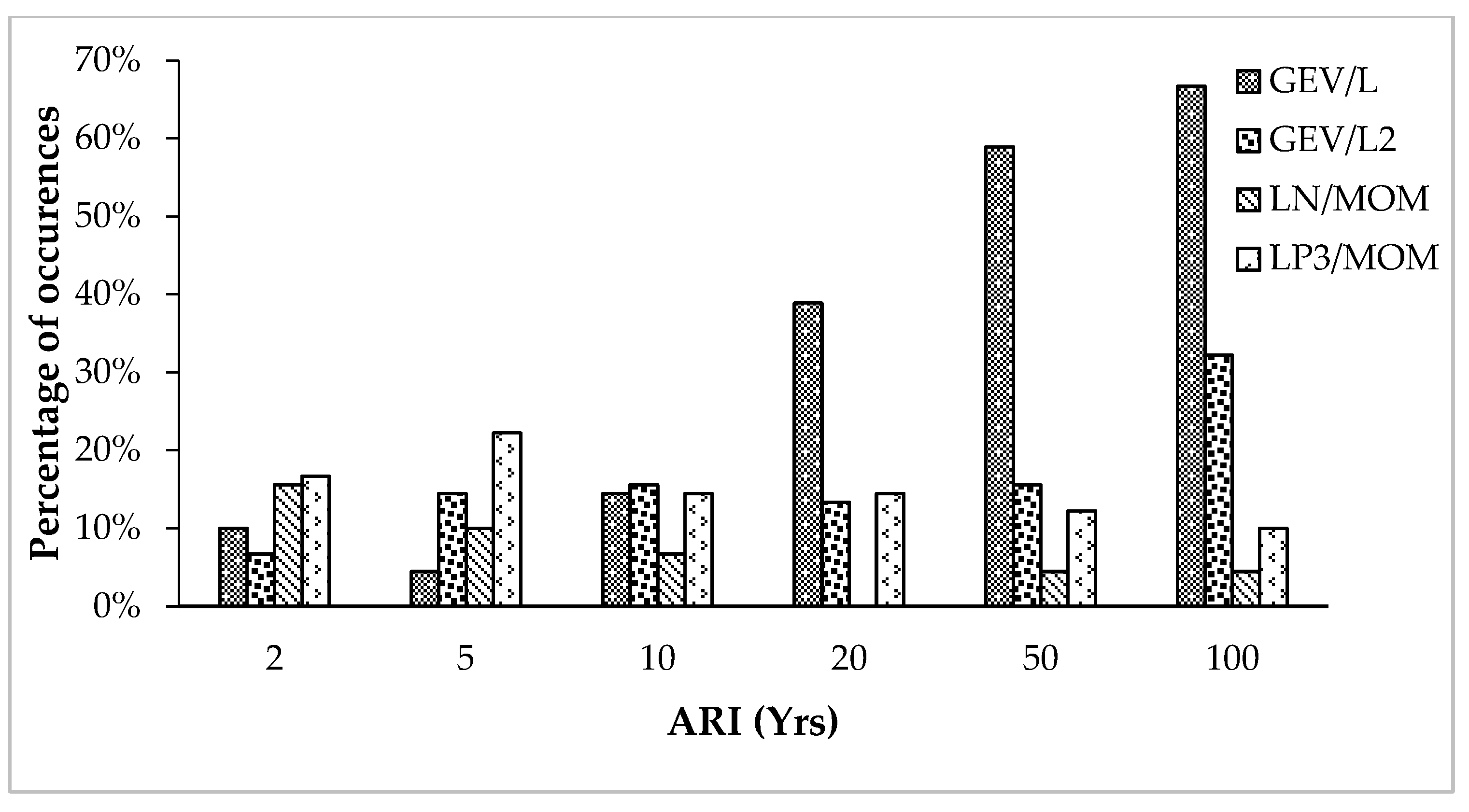
| Station No | Station Name | Record Length (Years) | Catchment Area (km2) | Major River Basin | Region | Region Reference |
|---|---|---|---|---|---|---|
| 4260504 | 4 KM East of Yundi | 37 | 191.0 | Lower Murray river | SA Murray–Darling Basin | A |
| 4260529 | U/S Cambrai | 15 | 239.0 | |||
| 4260533 | Near Hartley | 14 | 473.0 | |||
| 4260536 | Worlds end | 30 | 704.0 | |||
| 4260557 | D/S Mt. Barker | 18 | 88.0 | |||
| 4260558 | Dawesley | 28 | 43.0 | |||
| 5020502 | U/S Dam and Rd Br | 10 | 76.5 | Myponga | Adelaide and Mt. Lofty | B |
| 5030502 | Scott Bottom | 37 | 26.8 | Onkaparinga | ||
| 5030503 | 4.5 KM Wnw Kangarilla | 18 | 48.7 | |||
| 5030506 | U/S Mt Bold Res. | 17 | 34.2 | |||
| 5030507 | Lenswood | 15 | 16.5 | |||
| 5030508 | Craig bank | 30 | 8.4 | |||
| 5030509 | Aldgate Rly Station | 15 | 7.8 | |||
| 5030526 | Uraidla | 11 | 4.3 | |||
| 5040512 | Mt Pleasant | 33 | 26.0 | Torrens River | ||
| 5040517 | Waterfall Gully | 13 | 5.0 | |||
| 5040518 | U/S Minno Ck Junction | 13 | 19.0 | |||
| 5040523 | Castambul | 15 | 44.0 | |||
| 5040525 | U/S Millbrook Res | 12 | 23.0 | |||
| 5050502 | Yaldara | 18 | 384.0 | Gawler River | ||
| 5050504 | Turretfield | 34 | 708.0 | |||
| 5050517 | Penrice | 16 | 118.0 | |||
| 5060500 | Near Rhynie | 27 | 417.0 | Wakefield River | Northern and York | C |
| 5070500 | Near Andrews | 29 | 235.0 | Broughten River | ||
| 5070501 | Near Spalding | 31 | 280.0 | |||
| 5090503 | Old Kanyaka Ruins | 21 | 180.0 | Willochra Creek | ||
| 5130501 | U/S Gorge Falls (K.I.) | 33 | 190.0 | Kangaroo Island | Kangaroo Island | D |
| Station No | LN/MOM (Ml) | LP3/MOM (Ml) | GEV/L (Ml) | GEV/L2 (Ml) |
|---|---|---|---|---|
| A4260504 | 0.36 | 0.35 | 0.00 | 0.00 |
| A4260536 | 6.96 | 6.70 | 7.32 | 6.59 |
| A4260557 | 0.23 | 0.23 | 0.00 | 0.00 |
| A5020502 | 0.11 | 0.11 | 0.00 | 0.00 |
| A5030502 | 0.25 | 0.25 | 0.07 | 0.06 |
| A5030503 | 0.28 | 0.28 | 0.02 | 0.00 |
| A5030506 | 0.39 | 0.39 | 0.40 | 0.39 |
| A5030509 | 0.13 | 0.13 | 0.00 | 0.03 |
| A5030526 | 0.27 | 0.27 | 0.33 | 0.30 |
| A5040517 | 1.61 | 1.59 | 1.58 | 1.54 |
| A5040518 | 0.73 | 0.74 | 0.64 | 0.65 |
| A5040523 | 3.23 | 3.70 | 1.41 | 2.07 |
| A5050517 | 0.34 | 0.36 | 0.06 | 0.00 |
| A5060500 | 4.03 | 4.36 | 2.45 | 4.08 |
| A5070500 | 2.48 | 2.40 | 0.01 | 0.01 |
Publisher’s Note: MDPI stays neutral with regard to jurisdictional claims in published maps and institutional affiliations. |
© 2022 by the authors. Licensee MDPI, Basel, Switzerland. This article is an open access article distributed under the terms and conditions of the Creative Commons Attribution (CC BY) license (https://creativecommons.org/licenses/by/4.0/).
Share and Cite
Semananda, N.P.K.; Hewa, G.A. Estimation of Low Flow Statistics for Sustainable Water Resources Management in South Australia. Hydrology 2022, 9, 152. https://doi.org/10.3390/hydrology9090152
Semananda NPK, Hewa GA. Estimation of Low Flow Statistics for Sustainable Water Resources Management in South Australia. Hydrology. 2022; 9(9):152. https://doi.org/10.3390/hydrology9090152
Chicago/Turabian StyleSemananda, Niranjani P. K., and Guna A. Hewa. 2022. "Estimation of Low Flow Statistics for Sustainable Water Resources Management in South Australia" Hydrology 9, no. 9: 152. https://doi.org/10.3390/hydrology9090152
APA StyleSemananda, N. P. K., & Hewa, G. A. (2022). Estimation of Low Flow Statistics for Sustainable Water Resources Management in South Australia. Hydrology, 9(9), 152. https://doi.org/10.3390/hydrology9090152






